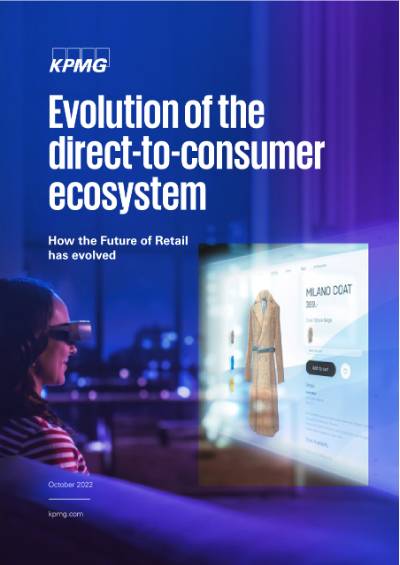Consumers want to shop direct
COVID-19 changed the face of retailing forever. Shuttered stores, disrupted supply chains, idle inventory and evolving health restrictions forced retailers and manufacturers to radically rethink their business models and revenue streams. It catalyzed rapid digitization and digital adoption. And it changed consumer buying patterns in the blink of an eye. As we noted in our Future of Retail report, physical stores will likely return to growth over the coming years. But those looking to drive growth through physical stores alone will surely struggle.
Yet the impact of the pandemic on retail business models is more nuanced than simply shifting consumers from physical to digital channels. Indeed, we have seen six key trends emerge to influence the retail landscape. And, while all of the trends were present prior to the pandemic, it is clear that the experience of COVID-19 has brought them squarely into the consumer decision-making process. Perhaps more importantly, these six trends have seeded the ground for the growth of D2C channels, creating unique opportunities for new D2C value propositions.
Businesses want to sell direct
Manufacturers and retailers also recognize the massive benefits that D2C models could provide. And many view the development of D2C channels as part of their longer-term strategy. Our conversations with key players suggest manufacturers and retailers are focused on delivering four key competitive advantages through their D2C investments.
- They want to get to market faster. D2C distribution gives brands immediate access to customers and channels, providing opportunities to distribute new innovative products, promotions, trials and subscription models. There are a growing number of ecommerce shopping platforms emerging in Asia, for example, that provide companies with their own official branded stores, thereby opening up rapid entry into multiple markets.
- They want better access to customer data. Those with a D2C strategy enjoy greater access to high volumes of customer data, empowering them to improve their sales activities and allowing them to better understand the customer lifecycle, purchase behavior and changing needs. Brands see D2C as a way to enhance their cross-selling, upselling and marketing activities. Many use their data to drive subscription-based services and personalization.
- They want to control the customer experience. Manufacturers using D2C gain greater influence over the overall sales strategy and brand image. They also get to increase their control over the customer experience. D2C allows manufacturers to build their own sales and marketing strategies and provide an end-to-end brand experience. Quick and direct customer feedback allows them to tailor offerings and shift the proposition as customer needs evolve.
- They want to improve their margins. A D2C strategy lets manufacturers bypass traditional distribution partners, saving around 15 percent from wholesalers and up to 40 percent from retailers. While marketing costs, customer acquisition costs and operational costs will likely rise significantly when moving to D2C, the shift can often provide brands with significantly more control over pricing and promotions, allowing them to influence margins and set prices to align with their view of their products’ value.
D2C growth skyrockets
With customers and manufacturers now keen on interacting, we are seeing massive growth in D2C channels. In part, the growth in D2C is interlinked to the growth in ecommerce experienced during the pandemic. Recent data suggest retail ecommerce grew by more than 26 percent in 2020 and more than 16 percent in 2021.

Retail ecommerce is expected to reach US$7.4 trillion with a CAGR of 12 percent over 2020–25
In 2020, one of the highest growth categories was D2C, scoring growth rates of nearly 45 percent over the year. While arguments could be made about the lasting nature of ecommerce growth during the initial phases of the pandemic, most forecasts suggest continued growth well into the future. Indeed, estimates suggest that ecommerce will continue to enjoy growth rates of around 11 percent until 2025. D2C market in the US is expected to grow at a CAGR of ~23 percent from 2019–23. Some markets have much more room to grow than others.
In China, for example, D2C accounts for about one-in-five online sales. In North America, around one-in-six online purchases go through a D2C channel. In India, that ratio is just one-in-fifty. With D2C penetration low and demand for online shopping high, manufacturers and retailers are eyeing a large and dynamic opportunity.
Yet they also know it is a complex opportunity — one that requires new (but aligned) business and operating models, dynamic partnerships, differentiated customer experiences and a massive amount of data and advanced analytics. This transition will likely require pace, capital and capabilities — with not all of these available in abundance for most organizations, many will need to proactively consider partnerships.

Source: Going Direct, Is direct to consumer selling set to revolutionise the manufacturing sector, Barclays, 20 November 2019; KPMG analysis (China data points)
D2C as a route to customer engagement?
Digital communities and influencers thrive on direct connections between consumers and businesses. And D2C gives them a chance to amplify their voices and reinforce their influence.
Glossier, a US-based D2C skincare and makeup company founded in 2014, knows how to use influencers and communities to drive direct sales. The company not only markets its products through partnerships with social media influencers, it also engages more directly with customers by, for example, featuring customers on their Instagram feed. In July 2021, Glossier raised US$80 million in funding, valuing the company at more than US$1.8 billion.
What Glossier understands — and what many D2C brands are learning — is that the best D2C experiences are created when brands capture and combine data from various channels to create a dynamic and holistic view of their customers, their needs and their preferences.
Continue reading
Contact us
Connect with us
- Find office locations kpmg.findOfficeLocations
- kpmg.emailUs
- Social media @ KPMG kpmg.socialMedia
Stay up to date with what matters to you
Gain access to personalized content based on your interests by signing up today





